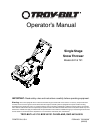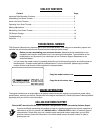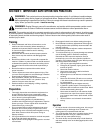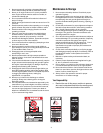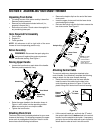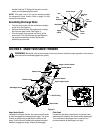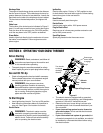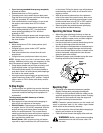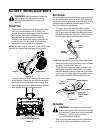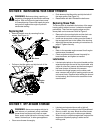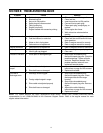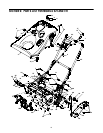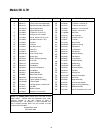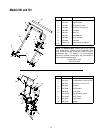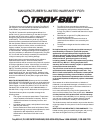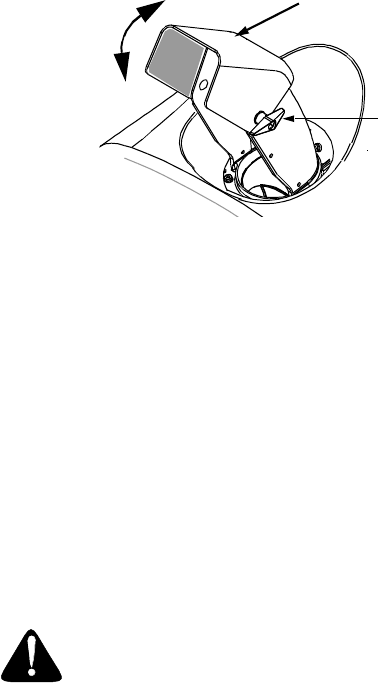
8
• If you have a grounded three-prong receptacle,
proceed as follows.
• Rotate choke lever to FULL position.
• Connect power cord to switch box on dash panel.
Plug the other end of power cord into a three-prong
120-volt, grounded, AC receptacle.
• Push starter button to crank engine. As you crank
the engine, move choke lever to FULL choke
position.
• When engine starts, release starter button, and
move choke gradually to OFF. If engine falters,
move choke immediately to FULL and then
gradually to OFF.
• When disconnecting the power cord, always unplug
from the three-prong receptacle first, and then from
the snow thrower.
Recoil Starter
• Move choke lever to FULL choke position (cold
engine start).
• If engine is warm, place choke in OFF position
instead of FULL.
• Push primer button two or three times for cold
engine start.
• If engine is warm, push primer button only once.
NOTE: Always cover vent hole in primer button when
pushing. Additional priming may be necessary for first
start if temperature is below 15 degrees Fahrenheit.
• Grasp starter handle and pull rope out slowly, until
it pulls slightly harder. Let rope rewind slowly.
• Pull starter handle rapidly. Do not allow handle to
snap back. Allow it to rewind slowly while keeping a
firm hold on the starter handle.
• As engine warms up and begins to operate evenly,
rotate choke lever slowly to OFF position. If engine
falters, return to FULL choke, then slowly move to
OFF position.
To Stop Engine
• To stop engine, turn ignition key counter-clockwise.
Disconnect the spark plug wire from the spark plug
to prevent accidental starting while equipment is
unattended.
To help prevent possible freeze-up of starter,
proceed as follows:
• Run engine for a few minutes before stopping to
help dry off any moisture on the engine.
• Electric Starter: Connect power cord to switch box
on engine, then to 120 volt AC receptacle. With the
engine running, push starter button and spin the
starter for several seconds. The unusual sound
made by spinning the starter will not harm engine or
starter. Disconnect the power cord from receptacle
first, and then from switch box.
Recoil Starter: With engine running, pull starter
rope with a rapid, continuous full arm stroke three
or four times. Pulling the starter rope will produce a
loud clattering sound, which is not harmful to the
engine or starter.
• Wipe all snow and moisture from the carburetor
cover in the area of the control levers. Also, move
control levers back and forth several times. Leave
throttle control lever in the STOP or OFF position.
Leave choke control in the FULL choke position.
• Remove ignition key and disconnect spark plug
wire to prevent accidental starting.
Operating the Snow Thrower
• Adjust the upper discharge chute up or down as
shown in Figure 7. You will have to loosen the hand
knob to adjust the upper chute, and then retighten
after correct adjustment is reached.
• Use the chute crank to position the discharge chute
in order to discharge snow with the wind.
• After making sure no bystanders or obstacles are in
front of the unit, engage the auger control handle.
As the snow thrower starts to move, maintain a firm
hold on the handle, and guide the snow thrower
along the path to be cleared.
• Release the auger control handle to stop the snow
throwing action and the forward motion.
Figure 7
Operating Tips
• Discharge snow downwind whenever possible.
Slightly overlap each previously cleared path.
• Lifting up on the handle will allow the rubber on the
augers to propel the snow thrower forward. Pushing
downward on the handle will raise the augers off
the ground and stop forward motion.
NOTE: Excessive upward pressure on the handle will
result in premature wear on the rubber auger blades
which would not be covered by warranty.
• Run the engine for a few minutes before stopping to
help dry any moisture on the engine.
• Clean the snow thrower thoroughly after each use.
WARNING: Muffler, engine and surrounding
areas become hot and can cause a burn. Do
not touch.
Hand
Knob
G
r
e
a
t
e
r
D
i
s
t
a
n
c
e
L
e
s
s
D
i
s
t
a
n
c
e
Upper
Discharge
Chute



